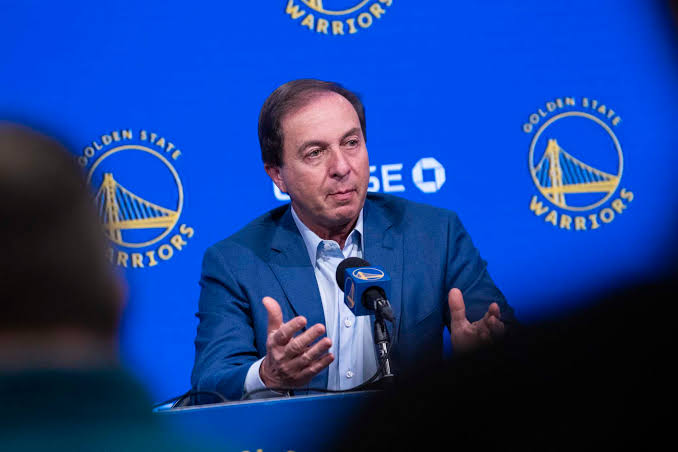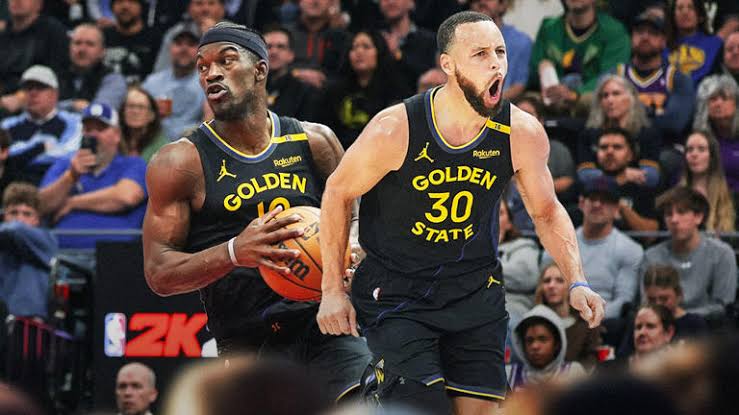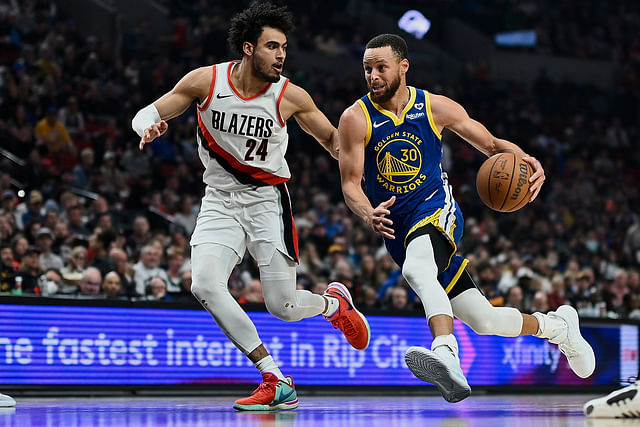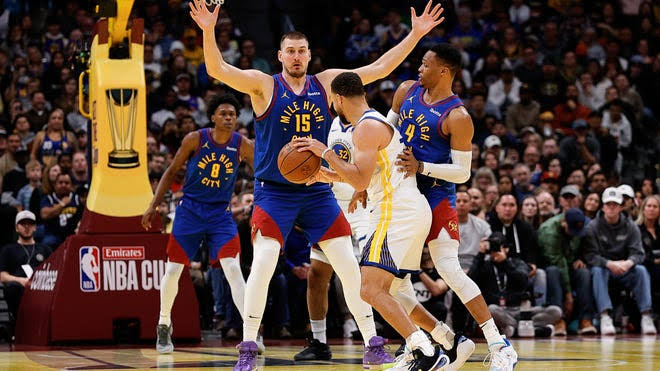Jonathan Kuminga‘s future could be decided over the next two months after the Golden State Warriors swung a win-now trade to acquire veteran point guard Dennis Schröder at the start of the trade season.
Kuminga is averaging 21.2 points, 5.2 rebounds and 2.4 assists since Warriors coach Steve Kerr expanded his role five games ago when he decided to bench Draymond Green in favor of the 22-year-old forward.
This December, Kuminga is shooting 49.1% from the field and 40% from the 3-point line.
“I’m very excited — 20 points tonight,” Warriors owner Joe Lacob told Tim Kawakami of The San Francisco Standard following the Warriors’ 143-133 loss to the Dallas Mavericks on December 15.
“I think he’s been playing pretty well. He’s been doing better, he’s getting better. He’s contributing a lot to our success. There’s nights you could say he’s been our second-best offensive weapon. He’s a good player. We like him a lot.”
But Kuminga’s breakout stretch this season has yet to translate to consistent winning for the Warriors. They have lost four of their six games this month as they fell to eighth place in the Western Conference with a 14-11 record after a strong 12-3 start.
The Warriors have until before the February 6 trade deadline to decide whether Kuminga will be part of their future or he’ll be the centerpiece of an outgoing trade package to acquire another win-now talent.
“I’m not going to speculate on that,” Lacob told Tim Kawakami of The San Francisco Standard when asked how tough it would be to trade him if it comes to that.
Butler Trade Rumors
With the Miami Heat open to listening offers for six-time NBA All-Star Jimmy Butler, the Warriors were one of the four teams he preferred to go next should a trade happen, according to ESPN’s Shams Charania.
The Warriors, however, did not jump into that opportunity right away.
“We’re in a time zone here of maximizing our window with Steph [Curry], Draymond, and Steve as our coach,” Dunleavy told reporters on a Zoom call on December 16 following the Schröder trade.
“For the most part, I feel good about this team, particularly on the defensive end, and now we have a player that we think could create and generate more offense for us. I want to evaluate and see, but we’ll always be looking at stuff.”
The next 25 games of the Warriors will decide the fate of this roster, especially Kuminga, and that of Schröder as well.
By making the Schröder trade before December 16, the Warriors can aggregate his salary in a potentially larger deal down the road for a star like Butler.
“Trades are hard. I’ve made this comment before,” Lacob told Kawakami.
“This one (Schröder trade) was available for us at the right time, and hopefully another one, might be two. … Obviously, if we keep losing, I’m going to want to … do something else.”
Kuminga’s Restricted Free Agency
There is still a good chance Kuminga stays in the Bay area past this season as he is an unrestricted free agent after this season.
If he stays past the trade deadline, the Warriors would have the right to match any offer sheet Kuminga can get from other teams in the offseason.
Two rebuilding teams — Brooklyn Nets and Washington Wizards — loom as a threat to lure Kuminga in the offseason as both teams will have the most cap room.
Kuminga was “aiming for” a $35 million annual salary during the extension talks with the Warriors, according to Anthony Slater of The Athletic. However, the Warriors weren’t willing to go above “around $30 million.”
“I can’t go into details of all that,” Lacob said of the contract talks.
“Of course we like him. We do have him under contract. He’s playing for us this year, and we have restricted free agency coming this summer. So it’s not like we really lost anything here. We get another chance to see him progress and … see how good he can be this year.”
More News…
NBA Team Values Explode to $4.6 Billion Average, with Warriors Leading the Charge
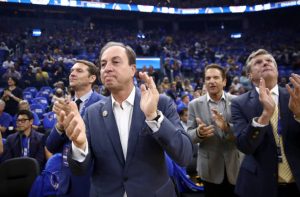
The NBA, where a Big Three combination of players often proves successful on the floor, has a Big Three in terms of franchise value, too.
The Golden State Warriors, New York Knicks and Los Angeles Lakers are the league’s most valuable franchises by a long distance, Sportico announced in its annual assessment on Wednesday.
The Warriors are worth $9.14 billion, the Knicks $8.3 billion and the Lakers $8.07 billion, per the report. Golden State is considered the second most valuable franchise in U.S. sports, trailing only the Dallas Cowboys ($10.3 billion).
The assessments include ownership’s real estate as well as team-related businesses such as WNBA franchises.
The average NBA team is worth $4.6 billion, a 15 percent rise over last year and nearly twice the worth from four years ago.
The Warriors, who have an affiliated WNBA expansion team set to start next year, saw their value go up 10 percent from 2023. The Knicks had a 12 percent rise, and the Lakers had a 10 percent hike.
The Brooklyn Nets are fourth on the list with a $5.7 billion value, a rise of 43 percent from the club’s 13th-place ranking last year. Billboard cited the Nets’ Barclays Center venue as the world’s highest-grossing arena as of April.
Rounding out the top 10 are the Los Angeles Clippers ($5.68 billion), the for-sale Boston Celtics ($5.66 billion), the Chicago Bulls ($5.56 billion), the Miami Heat ($5 billion), the Houston Rockets ($4.77 billion) and the Toronto Raptors ($4.66 billion).
Among the top 10 franchises, only the Lakers and Celtics don’t control their venues.
The bottom three on the list are the Minnesota Timberwolves ($3.29 billion), the New Orleans Pelicans ($3.09 billion) and the Memphis Grizzlies ($3.06 billion).
Per Sportico, NBA teams have a higher value-to-revenue ratio than those of any other major U.S. sports league. On that list, MLS is second, followed in order by the NFL, the NHL, the WNBA, the NWSL and MLB.
Read Also…
Shaq O’Neal Voices Big Complaint to Stephen Curry and Golden State
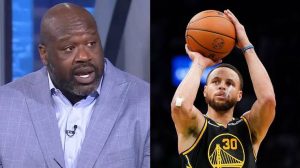
Shaquille O’Neal has never been one to hold back when discussing the state of the modern NBA, and his latest comments reflect strong feelings about the current direction of the game. He believes the league has adopted a softer style of play, one that lacks the physicality and competitiveness of past decades.
For O’Neal, the blame lies squarely on Stephen Curry and the Golden State Warriors, whose revolutionary focus on three-point shooting has created a league-wide obsession with perimeter play. He also warns that this one-dimensional approach could lead to a decline in fan interest.
“Steph Curry and those guys messed it up—Golden State back in the day shooting threes. But not every team is a three-point shooting team, so why does everybody have the same strategy? I think it makes the game boring,” said O’Neal.
He further added that the perceived softness of the league, driven by uniformity in playing style, could hurt viewership.“The game is soft, and I’ve said this before—it’s soft because everybody’s doing the same thing,” Shaq explained. “Viewership will continue to go down unless we switch things back up.”
The NBA has undergone a dramatic transformation over the past few decades, shifting from a sport defined by physicality and constant contact to one that prioritizes speed, open space, and long-range shooting. According to Shaquille O’Neal, this change has not only altered the style of play but also the way fans perceive the league.
During the 1990s and early 2000s, the NBA was synonymous with gritty, physical basketball. Battles in the paint and one-on-one matchups were the norm, with players like Shaq and Michael Jordan regularly facing tough, physical defenders on every possession.
In that era, referees allowed significantly more contact, and the concept of “soft fouls” was virtually nonexistent. Dominance in the post and aggressive drives to the rim were celebrated, while three-point shooting was used sparingly, reserved for strategic moments.
Today’s game tells a different story. Modern basketball emphasizes perimeter movement, spacing, and three-point shooting—a shift largely driven by the revolution sparked by Stephen Curry and the Golden State Warriors.
Entire teams have adopted this playstyle, prioritizing three-point attempts over physical drives to the basket. As a result, the emphasis on physicality has diminished, leading critics like O’Neal to label the game “too soft.”
For many fans, this transition has led to a loss of the intensity and physical drama that defined games during Shaq’s and Jordan’s eras. While the modern game is faster and more dynamic, some argue that it lacks the grit and stylistic diversity that made basketball so captivating in earlier decades.
